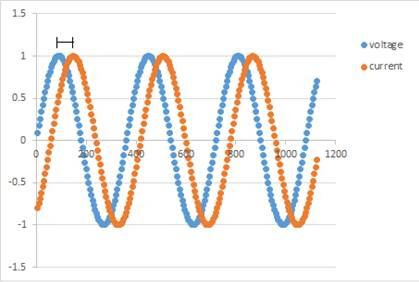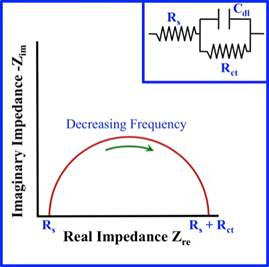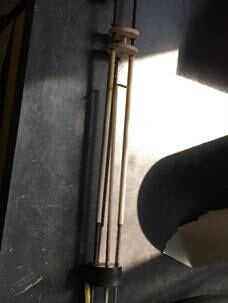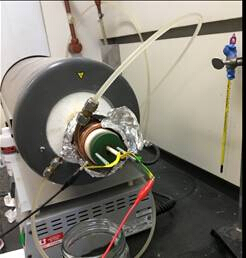Spectroscopie d'impédance électrochimique
Vue d'ensemble
Source : Kara Ingraham, Jared McCutchen, et Taylor D. Sparks, Department of Materials Science and Engineering, The University of Utah, Salt Lake City, UT
La résistance électrique est la capacité d'un élément de circuit électrique à résister à l'écoulement de l'électricité. La résistance est définie par la loi d'Ohm :
 (Équation 1)
(Équation 1)
Où  est
est  la tension et est le courant. La loi d'Ohm est utile pour déterminer la résistance des résistants idéaux. Cependant, de nombreux éléments de circuit sont plus complexes et ne peuvent pas être décrits par la seule résistance. Par exemple, si un courant alternatif (AC) est utilisé, la résistance dépendra souvent de la fréquence du signal AC. Au lieu d'utiliser la résistance seule, l'impédance électrique est une mesure plus précise et plus généralisable de la capacité d'un élément de circuit à résister au flux d'électricité.
la tension et est le courant. La loi d'Ohm est utile pour déterminer la résistance des résistants idéaux. Cependant, de nombreux éléments de circuit sont plus complexes et ne peuvent pas être décrits par la seule résistance. Par exemple, si un courant alternatif (AC) est utilisé, la résistance dépendra souvent de la fréquence du signal AC. Au lieu d'utiliser la résistance seule, l'impédance électrique est une mesure plus précise et plus généralisable de la capacité d'un élément de circuit à résister au flux d'électricité.
Le plus souvent, l'objectif des mesures d'impédance électrique est la déconvolution de l'empédance électrique totale d'un échantillon en contributions de différents mécanismes tels que la résistance, la capacité ou l'induction.
Principles
Pendant la spectroscopie d'impédance électrochimique (EIS), une tension AC est appliquée à un échantillon à différentes fréquences et le courant électrique est mesuré. Lorsqu'il s'agit de courants AC impedance ( ) remplace la résistance (
AC impedance ( ) remplace la résistance ( ) dans la loi d'Ohm. Si le signal AC d'origine est sinusoïdal, une réponse linéaire signifie que le courant produit sera également sinusoïdal, mais décalé en phase. La comptabilisation de la fréquence et du changement de phase de la tension et du courant est plus
) dans la loi d'Ohm. Si le signal AC d'origine est sinusoïdal, une réponse linéaire signifie que le courant produit sera également sinusoïdal, mais décalé en phase. La comptabilisation de la fréquence et du changement de phase de la tension et du courant est plus  facilement accomplie en utilisant la relation d'Euler et les nombres complexes où nous avons à la fois un composant réel et un composant imaginaire à . De là, nous pouvons construire des équations pour l'impédance pour différents composants d'un circuit:
facilement accomplie en utilisant la relation d'Euler et les nombres complexes où nous avons à la fois un composant réel et un composant imaginaire à . De là, nous pouvons construire des équations pour l'impédance pour différents composants d'un circuit:
1.Resistor:  (Équation 2)
(Équation 2)
2.Capacitors:  (Équation 3)
(Équation 3)
3.Inducteur:  (Équation 4)
(Équation 4)
 Où est la fréquence du
Où est la fréquence du  courant AC, est
courant AC, est  la capacité, est l'inductance, et
la capacité, est l'inductance, et  est l'unité imaginaire. De ces équations, vous pouvez voir que l'impédance en tant que résistance est indépendante de la fréquence, inversement liée à la fréquence comme condensateur, et la fréquence directement liée comme un inducteur.
est l'unité imaginaire. De ces équations, vous pouvez voir que l'impédance en tant que résistance est indépendante de la fréquence, inversement liée à la fréquence comme condensateur, et la fréquence directement liée comme un inducteur.
Une parcelle nyquiste est générée à partir de la réponse de fréquence à l'impédance électrique en traçant le composant imaginaire sur l'axe y et le composant réel sur l'axe x. L'instrument applique une tension de champ alternée à l'échantillon et mesure la réponse actuelle. Les composantes réelles et imaginaires de l'impédance sont calculées en déterminant le décalage de phase et le changement d'amplitude à différentes fréquences. Un exemple de cela est montré dans la figure 1. Cette parcelle est ensuite utilisée pour construire un modèle de circuit qui représente le mieux l'impédance de l'échantillon.

Figure 1 : Représentation du décalage de phase entre la tension appliquée et le courant mesuré.
L'une des intrigues nyquistes les plus simples est celle d'un demi-cercle que l'on peut voir à la figure 2. L'intrigue de la figure 2 est représentée par une résistance en série suivie d'une résistance et d'un condensateur en parallèle - c'est ce qu'on appelle la modélisation de circuits équivalente. Différents processus physiques correspondent à des éléments du modèle de circuit; par exemple, une double couche électrique correspond à un condensateur. Dans la figure 2, une parcelle de Nyquist est montrée qui est mieux modelée par une cellule Randle. C'est un point de départ commun pour l'interprétation d'une parcelle de terrain nyquiste. Une fois l'intrigue Nyquist terminée, le logiciel vous présentera des modèles de circuits équivalents que vous pouvez choisir pour modéliser vos données. Si l'intrigue Nyquist n'a pas un bon ajustement à partir des ajustements générés par ordinateur, vous pouvez construire votre propre circuit pour s'adapter aux données. Cependant, cela peut être une tâche compliquée. Il est important de commencer simple et de construire à partir de là. Il est également important de rester réaliste en fonction de ce que vous savez sur l'échantillon que vous testez, pour s'assurer que vous ne construisez pas un modèle irréaliste. Pour commencer, si le premier point est sur l'axe réel, il est généralement modélisé comme une résistance. Comme vous vous déplacez le long de la courbe, vous pouvez ajouter ou supprimer des éléments de circuit pour générer un meilleur ajustement.

Figure 2 : Image d'une parcelle de terrain nyquiste simple et de son modèle équivalent de cellules Randle.
Le concept que nous prévoyons de modéliser dans cette expérience est de savoir comment tester des échantillons avec EIS et utiliser la parcelle Nyquist pour construire un circuit modèle qui pourrait représenter les données d'impédance observées. Pour la première partie de l'expérience, nous allons démontrer comment exécuter un échantillon de contrôle qui produit un modèle de circuit connu que le logiciel peut facilement reconnaître. Pour la deuxième partie, nous pouvons démontrer comment tester un échantillon expérimental et à nouveau utiliser le logiciel pour générer un circuit modèle les meilleurs modèles de l'impédance électrique de l'échantillon.
Procédure
- Obtenir un module d'essai et le brancher aux instruments EIS via deux électrodes. Le module de test, illustré dans la figure 3, fournit des données qui peuvent être utilisées pour modéliser un circuit simple et connu. Il peut être utilisé pour confirmer que les fils sont reliés à la machine correctement et que toutes les pièces de la machine fonctionnent.

Figure 3: Module d'essai.
- Pour commencer à circuler le courant à travers l'échantillon, ouvrez le logiciel Zplot sur l'ordinateur. À partir de ce logiciel, vous pouvez configurer les paramètres de votre échantillon au besoin. Lors de l'exécution d'un test sur le module de test, sous "Polarisation", définir le potentiel DC à 0, AC Amplitude à 10 mV, et assurez-vous que la flèche déroulante dit, "vs. Open Circuit". Sous la section « Balayage de fréquence », fixez la fréquence initiale à 1x10-6 Hz, la fréquence finale à 100 Hz, et l'intervalle à 10. Sélectionnez également "logarithmique" et "Steps/Decade". Ensuite, appuyez sur "ok" pour commencer une nouvelle lecture.
- Ouvrez le logiciel Zview pour afficher les résultats. Sélectionnez z' et z'' pour tracer. Les résultats seront affichés sur l'axe négatif- pour les montrer sur l'axe positif, multiplier par -1. Cliquez sur "mesurer" puis "balayer" pour obtenir les valeurs z' et z' ' mesurées. Comparez ces valeurs mesurées aux valeurs attendues trouvées sur le devant du module de test, comme on le voit dans la figure 2. Si les valeurs correspondent, continuez à l'étape 4. Si ce n'est pas le cas, vérifiez tout le câblage et l'équipement pour voir si tout est connecté et fonctionne correctement.
- Détachez les électrodes du module d'essai.
- Préparer l'échantillon; pour la démonstration, nous utiliserons une alumine bêta disponible dans le commerce en la mettant dans l'assemblage indiqué dans la figure 4. Insérez cet assemblage dans le four à tubes, qui est situé dans la fumée du capot. Cette configuration est nécessaire car les tests EIS sont généralement exécutés par amplitude (ou tension) variable sur une certaine période. Pour la simplification, nous allons exécuter cette expérience à température ambiante seulement.

Figure 4: Assemblage dans lequel l'échantillon sera inséré.
- Fixez les électrodes à l'assemblage comme indiqué dans la figure 5.

Figure 5: Assemblage d'échantillons,dans la fumée du capot, avec des électrodes attachées.
- Ouvrez le logiciel Zplot et définiz les paramètres. Pour cette expérience, les paramètres seront les mêmes qu'à l'étape 2.
- Obtenir les parcelles en utilisant la même procédure que l'étape 3 (sauf les valeurs z' et z'' n'ont pas besoin d'être comparées au module de test). Sauvez les parcelles.
- Cliquez sur le bouton " ajustement instantané " et choisissez deux points pour s'adapter au demi-cercle. Utilisez le logiciel pour choisir le meilleur modèle de circuit équivalent.
Résultats
Les résultats de l'EIE sont souvent présentés dans une parcelle nyquiste, qui montre une réelle impédance par rapport à l'impédance complexe à chaque fréquence testée. L'intrigue de l'expérience a été présentée dans la figure 6.

Figure 6: Capture d'écran de l'ordinateur après l'obtention de l'intrigue de Nyquist.
Comme on le voit à l'étape 9 de la procédure, le logiciel vous donnera des options de circuits pour modéliser vos données. Il est préférable de choisir le modèle le plus simple qui reflète encore fidèlement les données. Choisir le circuit correct pour modéliser les données est un problème difficile et inverse. Bien qu'il existe des progiciels qui peuvent aider à générer des circuits de modèles, il faut prendre soin de ces analyses.
Lorsqu'un circuit équivalent est choisi, les données obtenues peuvent être utilisées pour calculer la conductivité de l'échantillon. Une façon de calculer la conductivité est de tracer les données de l'EIE à l'aide d'un modèle Arrhenius, qui trace 1000/T sur l'axe x et le journal (T) sur l'axe y. Les données peuvent être montées sur une ligne linéaire en utilisant l'équation suivante :
 (Équation 5)
(Équation 5)
Alors  que pour notre échantillon était 374 S/cm-K et Ea, l'énergie d'activation, était de 0,17 eV, et T 298 K. Brancher ces valeurs, nous avons calculé une conductivité de 1,67 x 10-3 S/cm. Des expériences antérieures avec cet échantillon ont indiqué que sa conductivité était d'environ 4,1 x 10-3 S/cm. C'est assez similaire à la valeur de conductivité que nous avons calculée, ce qui indique que le modèle que nous avons choisi était un bon, mais pas parfait, ajustement.
que pour notre échantillon était 374 S/cm-K et Ea, l'énergie d'activation, était de 0,17 eV, et T 298 K. Brancher ces valeurs, nous avons calculé une conductivité de 1,67 x 10-3 S/cm. Des expériences antérieures avec cet échantillon ont indiqué que sa conductivité était d'environ 4,1 x 10-3 S/cm. C'est assez similaire à la valeur de conductivité que nous avons calculée, ce qui indique que le modèle que nous avons choisi était un bon, mais pas parfait, ajustement.
Applications et Résumé
La spectroscopie électrochimique d'impédance est un outil utile pour déterminer comment un nouveau matériau ou dispositif empêche le flux d'électricité. Pour ce faire, il applique un signal AC à travers les électrodes reliées à l'échantillon. Les données sont collectées et tracées par l'ordinateur dans la plaine complexe. Avec l'aide d'un logiciel, le graphique peut être modélisé sur des parties spécifiques d'un circuit. Ces données peuvent souvent être très compliquées et nécessitent une analyse minutieuse. Cette technique, aussi complexe soit-elle, est un moyen non destructif extrêmement utile d'interroger les complexités réelles de l'impédance électrique, et peut fournir des modèles utiles de la façon dont le courant AC se comporte lorsqu'il est appliqué sur l'échantillon.
L'EIE peut être utilisé pour examiner les micro-organismes dans un échantillon. Lorsque les bactéries se développent sur un échantillon, cela peut modifier la conductivité électrique de l'échantillon. En utilisant cette idée, vous pouvez mesurer l'impédance d'un échantillon à une fréquence pour déterminer la population de micro-organismes. Cette technique est connue sous le nom de microbiologie de l'impédance.
EIS peut également être utilisé pour dépister le cancer dans les tissus, connu sous le nom d'impédance électrique de tissu. L'impédance électrique du tissu corporel est déterminée par sa structure. Comme il se dégrade au fil du temps, c'est l'impédance du courant électrique change également. Tout comme la microbiologie de l'impédance, ce type de test d'impédance examine la population de cellules et peut fournir des informations utiles sur la santé cellulaire et la morphologie.
L'EIE est également utilisé dans les industries de la peinture et de la prévention de la corrosion pour déterminer dans quelle mesure une couche est appliquée à la surface d'un matériau. Les données EIS correspondent bien aux processus électrochimiques quotidiens qui attaquent les surfaces ; matériaux qui présentent une résistance  électrique de moins que ne peut pas protéger contre la corrosion ainsi que les matériaux avec une résistance plus élevée. L'EIE est un moyen de prédire comment les nouveaux traitements de surface seront équitables dans des environnements difficiles sans avoir à les recréer, ce qui en fait un outil inestimable dans la prévention de la corrosion qui, autrement, coûterait aux États-Unis des milliards de dollars en réparations chaque année.
électrique de moins que ne peut pas protéger contre la corrosion ainsi que les matériaux avec une résistance plus élevée. L'EIE est un moyen de prédire comment les nouveaux traitements de surface seront équitables dans des environnements difficiles sans avoir à les recréer, ce qui en fait un outil inestimable dans la prévention de la corrosion qui, autrement, coûterait aux États-Unis des milliards de dollars en réparations chaque année.
Tags
Passer à...
Vidéos de cette collection:

Now Playing
Spectroscopie d'impédance électrochimique
Materials Engineering
23.4K Vues

Matérialographie optique I : Préparation de l'échantillon
Materials Engineering
15.5K Vues

Matérialographie optique II : Analyse d'image
Materials Engineering
11.1K Vues

Spectroscopie photoélectronique à rayons X
Materials Engineering
21.8K Vues

Diffraction des rayons X
Materials Engineering
89.4K Vues

Faisceaux d'ions focalisés
Materials Engineering
8.9K Vues

Solidification directionnelle et stabilisation de phase
Materials Engineering
6.6K Vues

Calorimétrie différentielle à balayage
Materials Engineering
38.3K Vues

Diffusivité thermique et méthode du flash laser
Materials Engineering
13.3K Vues

Dépôt électrolytique sur films minces
Materials Engineering
20.2K Vues

Analyse de la dilatation thermique par dilatométrie
Materials Engineering
15.9K Vues

Matériaux composites à matrice céramique et leurs propriétés de flexion
Materials Engineering
8.3K Vues

Alliages nanocristallins et stabilité de la taille des nano-grains
Materials Engineering
5.2K Vues

Synthèse des hydrogels
Materials Engineering
23.8K Vues